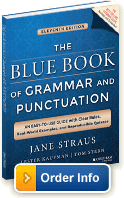|
Welcome to your GrammarBook.com e-newsletter.
|
“Your newsletters are absolute eye-openers, and I enjoy reading every single one.”
—Fran D.
“The Blue Book of Grammar and Punctuation has made me a better writer. It’s the only explanation of grammar I understand.”
—Gary T.
“GrammarBook.com is amazing! I've spent some time on the quizzes and have been impressed.”
—Kerri M.
|
|
|
More Of
Earlier this month we observed some of the ways that little of can bring big trouble to students of English. Unfortunately, we aren’t done
yet.
We previously discussed certain sentences in which the verb is derived not from the subject, but from the object of the preposition of.
Here’s an example: She is one of those people who love to travel. Not loves to travel. The verb is
determined by people, not by one.
Similarly, with many words that indicate
portions—some, most, all, etc.—we are guided by the object of of. If the noun after of is singular, we use a singular verb: Some of the pie is left. If it’s plural, we use a plural
verb: Some of the books are gone.
With collective nouns such as crowd or family, the speaker or writer has leeway since such words, though singular in
form, denote more than one person or thing. Therefore, Most of my family is here and Most of my family are here are both grammatical sentences.
Other areas of concern:
• Off of Drop of. Off of is not a valid phrasal preposition. In sentences like Keep off of the grass or You ought to come off of your high horse, the of adds nothing.
• Outside of We stood outside of the building. Make it outside the building. In sentences indicating
location, “of is superfluous with outside,” says Roy H. Copperud. His fellow English scholar Theodore M. Bernstein calls outside of “a substandard casualism.” With sentences where outside of is not literal, such as Outside of you, I have no one, there are better alternatives available, including except for, other than, besides, apart from, and aside from.
• All of When a pronoun is involved, the of is essential, as in phrases like all of it and all of us.
When a possessive noun is preceded by a or an, or has no modifier, again the of is required: all of a book’s wisdom, all of history’s lessons. But when a noun is preceded by an adjective or by the,
it’s leaner and cleaner to drop the of in all of: all my books, all the lessons of history.
• Out of The of is necessary; only bumpkins say Get out my house. Two notable exceptions: door and window—no of is needed in We hurried out the door or I stared out the window.
• Couple of The of stays. This includes phrases such as a couple of things, a couple of more things, a couple of hundred things. “Omitting the of is slipshod,” says Bryan A. Garner in A Dictionary of Modern American Usage. “Using couple not as a noun but as an adjective is poor usage.”
That’s enough of for a while. Amazing the confusion that one pint-size preposition can cause.
Because of the e-newsletter's large readership, please submit your English usage questions through GrammarBook.com's “Grammar Blog.” |
|
Pop Quiz
Fix any problems with of that you come across.
1. One of those trees that’s been around for over a century is standing just outside of the restaurant.
2. It’s a little place right outside of San Rafael, just off of Route 101.
3. He threw all of himself into making all Bonnie’s family comfortable.
4. I was looking out of the window as a couple dozen people rushed out the burning building.
Free BONUS Quiz for You!
[[firstname]], because you are a subscriber to the newsletter, you get access to one of the Subscription Members-Only Quizzes. Click here to take a Problems with Prepositions Quiz and get your scores and explanations instantly!
Good News for Quiz Subscribers
First, we are excited to inform our instructor-level quiz subscribers of several significant improvements to your subscription at no added cost to you:
- You may opt out of receiving e-mails when students complete quizzes.
- You may now assign multiple quizzes at a time.
- You may now assign a starting date and ending date when quizzes will be available to students.
- You can now download a spreadsheet containing the results of all quizzes taken by each student.
Second, after logging on, all quiz subscribers may now enjoy GrammarBook.com free of advertisements (excluding the Grammar Blog).

“So convenient … hundreds of quizzes in one click.”
[[firstname]], Subscribe to receive hundreds of English usage quizzes not found anywhere else!
- Take the quizzes online or download and copy them.
- Get scored instantly.
- Find explanations for every quiz answer.
- Reproduce the quizzes to your heart's content.
- EASY to use.
- No software to download.
- No setup time.
- A real person to help you if you have any questions!
“Fun to test my skills!”
“The explanations really help … thanks!”
Your choice: Subscribe at the $29.95 or $99.95 level ($30 off - regularly $129.95).
“I download the quizzes for my students who don't have computer access.”
Subscribe today to receive hundreds of English usage quizzes not found anywhere else!
“Makes learning English FUN!”
 |
Don't need all the quizzes at once?
You can now purchase the same quizzes individually for ONLY 99¢ each. Purchase yours here. |

Get Yours Today!
Get Amazon’s No. 1 Best-seller in Four Categories!
No. 1 in Grammar
No. 1 in Reading
No. 1 in Lesson Planning
No. 1 in Vocabulary |
The Blue Book of Grammar
and Punctuation
by Jane Straus, Lester Kaufman, and Tom Stern
The Authority on English Grammar!
Eleventh Edition Now Available
Have You Ordered Your Copy Yet?
An indispensable tool for busy professionals, teachers, students, homeschool families, editors, writers, and proofreaders.
Available in print AND as an e-Book! Over 2,000 copies are purchased every month!
Order Your Copy Today!
- Hundreds of Grammar, Punctuation, Capitalization, and Usage Rules
- Real-World Examples
- Spelling / Vocabulary / Confusing Words
- Quizzes with Answers
The publisher is extending its pre-publication discount offer until August 30! If you live in the United States or Canada, order the new edition of The Blue Book
through Wiley.com and get 30 percent off and FREE shipping. Simply go to bit.ly/1996hkA and use discount code E9X4AYY.
For those of you who live outside the U.S. and Canada, although the publisher is not able to offer free shipping, you will get 35 percent off to help offset your shipping costs. Simply go to bit.ly/1996hkA and use discount code E9X4A. |
Changes Coming to Our GrammarBook.com Website
We want to alert all our newsletter readers and visitors to our website that we will soon begin updating the English Rules section of GrammarBook.com to reflect the contents of the eleventh edition of The Blue Book of Grammar and Punctuation. These revisions will take place over the next couple of months.
We researched the leading reference books on American English grammar and punctuation including The Chicago Manual of Style, The Associated Press Stylebook, Fowler's Modern English Usage, Bernstein's The Careful Writer, and many others. As before, we will provide rules, guidance, and examples based on areas of general agreement among these authorities. Where the authorities differ, we will emphasize guidance and provide options to follow based on your purpose in writing, with this general advice: be consistent.
 Wordplay Wordplay
Following are more selections from a perverse set of rules that are guilty of the very mistakes they seek to prevent. English teachers, students, scientists, and writers have been circulating these self-contradictory rules for more than a century.
Rules for Writing Good: Writing Tips
1. Don't be a person whom people realize confuses who and whom.
2. Never use no double negatives.
3. When writing, participles must not be dangled.
Pop Quiz Answers
1. One of those trees that have been around for over a century is standing just outside the restaurant.
2. It’s a little place right outside San Rafael, just off Route 101.
3. He threw all of himself into making all of Bonnie’s family comfortable.
4. I was looking out the window as a couple of dozen people rushed out of the burning building.
Learn all about who and whom, affect and effect, subjects and verbs, adjectives and adverbs, commas, semicolons, quotation marks, and much more by just sitting back and enjoying these easy-to-follow lessons. Tell your colleagues (and boss), children, teachers, and friends. Click here to watch. |




 Wordplay
Wordplay
